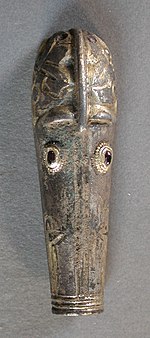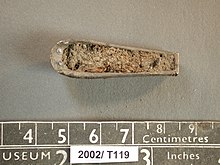Horncastle helmet fragment Contents Description Discovery Typology Iconography References Bibliography Navigation menu"Anglo Saxon grave goods"Beowulf and The Fight at FinnsburgTreasure Annual Report 2002"Notes and News: A Boar Figurine from Guilden Morden, Cambs"10.5284/1000320plate XIV"Record ID: PAS-5D5B56 - EARLY MEDIEVAL helmet""The Staffordshire (Ogley Hay) Hoard: Recovery of a Treasure"10.1017/S0003598X00067545"Helm und Ringschwert: Prunkbewaffnung und Rangabzeichen germanischer Krieger"The Agricola and Germania of TacitusThe Agricola and Germania of Tacitus: With a Revised Text, English Notes, and MapsThe Anglian Helmet from 16–22 CoppergateTreasure Annual Report 2002e
AgighiolAgrisBenty GrangeCanterburyCiumeştiCoppergateCoțofeneștiCoventry SalletCrosby GarrettEmesaGevningeGjermundbuGuilden MordenGuisboroughHallatonHorncastleIron GatesLokrumeMeyrickNewsteadNijmegenPeretuPioneerRibchesterShorwellStaffordshireSutton HooTjeleVenetianWaterlooWitcham GravelAtticBoar's tuskBoeotianChalcidianCoolusCorinthianGaleaIllyrianImperialKegelhelmKonosLate Roman ridgeMontefortinoNegauPhrygianShmarjetArmetAventailBarbuteBascinetBurgonetCervelliereCloseEnclosedFalling buffeFrog-mouthGreatHounskullKabutoKettleKulah khudLamellenhelmLobster-tailed potMempoMorionNasalPickelhaubeSalletSecreteSpangenhelmTurbanVikingAdrianBrodieBulgarian M36Danish M1923German StahlhelmGreek M1934/39HSATItalian M33M42 DuperiteM1M1CMk IIIPortuguese M1940Polish wz. 31RACSoviet of WWIISSK 90Type 92 TetsuboSwiss L'EplattenierCABAL IICCBCzechoslovakian Vz. 53 HelmetCG634GK80JK 96Mº 44 E.T.A.M59/85M63M76 ParaMk IVMk 6Modèle 1951Modèle 1978MPC-1OR-201ParatrooperSSh-60SSh-68Type 666B27Advanced CombatEnhanced Combat (Aust)Enhanced Combat (US)Future Assault Shell Technology (FAST)GOLFOHead Gear SystemM92Iraqi M80M59/85Iraqi M90LightweightModular Integrated CommunicationsM87Mk 7QGF03QGF11SferaSPECTRAPASGTBattingCoolfloBicycleStackhatCricketDivingEquestrianGridiron footballEyeshieldRevolutionHockeyLacrosseMotorcycleRacingScrum capSkiHeraldic useHornedMahioleTarnhelmPithAmerican fiberWingedZuckerman
7th century in England7th-century works2002 archaeological discoveries2002 in EnglandAnglo-Saxon archaeologyAnglo-Saxon EnglandHistory of LincolnshireMammals in artMedieval helmetsMedieval European objects in the British Museum
Anglo-SaxonHorncastleLincolnshireCity and County MuseumLincolnquadrupedGarnetsgildedBenty GrangeWollastonSutton Hoo helmetGermanic mythologyTacitusBalticAestigildedlentoidcabochongarnetsfiligreereliefquadrupedHorncastlemarket townmetal detectorTreasure Act 1996The CollectionArt FundLincolnshire County CouncilSutton Hoo helmetStaffordshire helmetBenty GrangeWolasstonGuilden MordenYorkboarLa TèneGaulishmother goddessIron AgeTacitusBalticAestiGundestrup cauldronTorslunda platelegionstwentiethGermanic traditionRoman rule in BritainFreyjaFreyr
| Horncastle helmet fragment | |
|---|---|
 The Horncastle helmet fragment | |
| Material | Silver, gold, garnets |
| Created | c. 600–650 AD |
| Discovered | 2002 Horncastle, Lincolnshire |
| Present location | The Collection, Lincoln |
The Horncastle helmet fragment is a decorated Anglo-Saxon boar's head that likely was once attached to the crest of a helmet. Dating to the first half of the seventh century AD, it was discovered in 2002 by a metal detectorist searching in the town of Horncastle, Lincolnshire. It was reported as found treasure and purchased for £15,000 by the City and County Museum, now known as The Collection, in Lincoln. As of 2018 the museum has the fragment on display.
The 40 mm (1.6 in) long fragment is made of silver. The elongated head is semi-naturalistic, and depicts a crouching quadruped on either side of the skull. A mane divides the head down the centre. Garnets form the boar's eyes, and its eyebrows, skull, mouth, tusks, and snout are gilded. The head is hollow; in the space underneath, which was filled with soil and plant matter when found, are three rivets that would have affixed the fragment to a larger object, such as a helmet. The fragment would likely have formed the terminal of one of the "crested helmets" used in Northern Europe during the sixth through eleventh centuries.
The boar's head terminal is one of several representations of the animal on contemporary helmets. Boars surmount the Benty Grange and Wollaston helmets, and form the ends of the eyebrows of the Sutton Hoo helmet. These evidence a thousand-years-long tradition in Germanic mythology associating the boar with the gods, and with protection. The Roman historian Tacitus suggested that the Baltic Aesti wore boar symbols in battle to invoke the protection of a mother goddess, while in the Anglo-Saxon epic Beowulf, the poet writes of boar symbols on helmets keeping watch over the warriors wearing them.
Contents
1 Description
2 Discovery
3 Typology
4 Iconography
5 References
6 Bibliography
Description

The bottom of the fragment, showing three rivets and still filled with dirt
The boar's head is made of silver, parts of which are gilded, and has garnet eyes.[1][2] It is 40 mm (1.6 in) long, and semi-naturalistic in style.[2][3] The head is elongated; a prominent mane runs down the middle and terminates in a blunt snout, indicated by three grooved and gilded lines.[1][2] On each side above the snout are more grooved and gilded lines representing the mouth, including pointed tusks.[1][2] Two small eyes are formed with lentoid cabochon garnets set in beaded gold filigree work with a double collar.[2][3] Two gilded eyebrows, cast in relief, are well clear of the eyes and set against the skull.[1][2] This is also gilded, and repeats on either side the pattern of a crouching quadruped with three toes on front and back feet and head twisted backwards, its jaws biting across its body and back foot.[1][2]
The fragment is hollow, and was found filled with soil and plant roots.[1][2] Three rivets on the underside—one near the mouth, two on the opposite end—would have served to attach it to a larger object, most likely a helmet.[1][2]
Discovery
The fragment was found on 1 May 2002 in Horncastle, a market town in Lincolnshire, England.[1][2] It was found by a Mr D. Turner, who was searching with a metal detector.[1] As required of found objects more than 300 years old and with more than a 10% silver content, it was reported under the Treasure Act 1996, and subsequently declared treasure.[2] It was valued at £15,000,[4] and purchased by the City and County Museum, Lincoln—now known simply as The Collection.[5] Funds for the acquisition were raised from the Art Fund, the MLA/V&A Purchase Grant Fund, Friends of Lincoln Museum & Art Gallery, and the Lincolnshire County Council Heritage Service Purchase Fund.[5] As of 2018 the fragment is on display at The Collection amidst a variety of Anglo-Saxon grave goods.[6]
Typology

Horse head terminal from the Staffordshire helmet
The boar is of Anglo-Saxon origin, and is dated to the first half of the seventh century AD.[2][3] Although its original purpose can not be conclusively determined, the style and size of the boar suggests that it formed the terminal of a helmet crest.[5] Figural terminals adorn the crests of many contemporary helmets,[7] such as the Sutton Hoo helmet, which has a dragon terminal at either end,[5] and the Staffordshire helmet, which features a horse head terminal.[8] Boar iconography is also found on helmets from the period, typically on the crests, as with the Benty Grange, Wolasston and Guilden Morden examples,[9][10] or at the ends of the eyebrows, as on those from Sutton Hoo and perhaps York.[2][5][11] The Horncastle fragment, with its lentoid eyes, tusks, and defined mane, is stylistically similar to the boar atop the Benty Grange helmet.[2][5]
Taken in context, the boar would likely have adorned an early model of the "crested helmets" known in Northern Europe in the sixth through eleventh centuries AD.[12][13] Such helmets are characterised by a rounded cap and usually a prominent nose-to-nape crest,[14] from which the name of the helmet type derives and at one end of which the Horncastle boar was probably once attached.[5]
Iconography

A Central European boar
The boar was an important symbol in prehistoric Europe, where it was "venerated, eulogised, hunted and eaten ... for millennia, until its virtual extinction in recent historical time."[15] Anglo-Saxon boar symbols follow a thousand years of similar iconography, coming after La Tène examples in the fourth century BC, Gaulish examples three centuries later, and Roman boars in the fourth century AD.[16] They likely represent a fused tradition of European and Mediterranean cultures.[17] The boar is said to have been sacred to a mother goddess figure among linguistically Celtic communities in Iron Age Europe,[18] while the Roman historian Tacitus, writing around the first century AD, suggested that the Baltic Aesti wore boar symbols in battle to invoke her protection.[19][20] Boar-crested helmets are depicted on the turn of the millennium Gundestrup cauldron, discovered in Denmark, and on a Torslunda plate from Sweden, made some five hundred years later.[18] Though the Romans also included the boar in their stable of symbols—four legions,[16] including the twentieth,[21] adopted it as their emblem—it was only one among many.[18] The boar nonetheless persisted in continental Germanic tradition during the nearly 400 years of Roman rule in Britain, such as in association with the Scandinavian gods Freyja[22][23] and Freyr.[24] Its return to prominence in the Anglo-Saxon period, as represented by the boars from Benty Grange, Wollaston, Guilden Morden, and Horncastle, may therefore suggest the post-Roman reintroduction of a Germanic tradition from Europe, rather than the continuation of a tradition in Britain through 400 years of Roman rule.[22] Whatever its precise symbolism, the Anglo-Saxon boar appears to have been associated with protection; the Beowulf poet makes this clear, writing that boar symbols on helmets kept watch over the warriors wearing them.[25][26]
References
^ abcdefghi Evans 2004, p. 53.
^ abcdefghijklmn Portable Antiquities Scheme 2012.
^ abc Evans 2004, pp. 53–54.
^ Treasure Report Valuations 2004.
^ abcdefg Evans 2004, p. 54.
^ The Collection grave goods.
^ Steuer 1987, p. 200.
^ Leahy et al. 2011, p. 217.
^ Foster 1977a.
^ Meadows 2004, p. 16.
^ Tweddle 1992, pp. 1015–1016.
^ Steuer 1987, pp. 199–203, 230–231.
^ Tweddle 1992, pp. 1083, 1086.
^ Tweddle 1992, p. 1083.
^ Foster 1977b, p. 1.
^ ab Frank 2008, p. 78.
^ Frank 2008, p. 82.
^ abc Foster 1977b, p. 5.
^ Tacitus 1868, p. 31.
^ Tacitus 1886, p. 25.
^ Foster 1977b, pp. 15, 19, 26.
^ ab Foster 1977b, p. 27.
^ Frank 2008, p. 80.
^ Frank 2008, p. 86.
^ Beowulf, ll. 303–306.
^ Chaney 1970, pp. 123–124.
Bibliography
"Anglo Saxon grave goods". The Collection: Art and Archaeology in Lincolnshire. Retrieved 21 February 2018..mw-parser-output cite.citationfont-style:inherit.mw-parser-output .citation qquotes:"""""""'""'".mw-parser-output .citation .cs1-lock-free abackground:url("//upload.wikimedia.org/wikipedia/commons/thumb/6/65/Lock-green.svg/9px-Lock-green.svg.png")no-repeat;background-position:right .1em center.mw-parser-output .citation .cs1-lock-limited a,.mw-parser-output .citation .cs1-lock-registration abackground:url("//upload.wikimedia.org/wikipedia/commons/thumb/d/d6/Lock-gray-alt-2.svg/9px-Lock-gray-alt-2.svg.png")no-repeat;background-position:right .1em center.mw-parser-output .citation .cs1-lock-subscription abackground:url("//upload.wikimedia.org/wikipedia/commons/thumb/a/aa/Lock-red-alt-2.svg/9px-Lock-red-alt-2.svg.png")no-repeat;background-position:right .1em center.mw-parser-output .cs1-subscription,.mw-parser-output .cs1-registrationcolor:#555.mw-parser-output .cs1-subscription span,.mw-parser-output .cs1-registration spanborder-bottom:1px dotted;cursor:help.mw-parser-output .cs1-ws-icon abackground:url("//upload.wikimedia.org/wikipedia/commons/thumb/4/4c/Wikisource-logo.svg/12px-Wikisource-logo.svg.png")no-repeat;background-position:right .1em center.mw-parser-output code.cs1-codecolor:inherit;background:inherit;border:inherit;padding:inherit.mw-parser-output .cs1-hidden-errordisplay:none;font-size:100%.mw-parser-output .cs1-visible-errorfont-size:100%.mw-parser-output .cs1-maintdisplay:none;color:#33aa33;margin-left:0.3em.mw-parser-output .cs1-subscription,.mw-parser-output .cs1-registration,.mw-parser-output .cs1-formatfont-size:95%.mw-parser-output .cs1-kern-left,.mw-parser-output .cs1-kern-wl-leftpadding-left:0.2em.mw-parser-output .cs1-kern-right,.mw-parser-output .cs1-kern-wl-rightpadding-right:0.2em
Beowulf. n.d.
- Old English available in the Klaeber text, published as Klaeber, Friedrich (1922). Beowulf and The Fight at Finnsburg. Boston: D.C. Heath & Company.

- Old English available in the Klaeber text, published as Klaeber, Friedrich (1922). Beowulf and The Fight at Finnsburg. Boston: D.C. Heath & Company.
Chaney, William A. (1970). The Cult of Kingship in Anglo-Saxon England: The Transition from Paganism to Christianity. Manchester: Manchester University Press.
Evans, Angela C. (October 2004). "Horncastle, Lincolnshire: Anglo-Saxon parcel-gilt terminal in the form of a boar's head (2002 T119) (fig. 41)". Treasure Annual Report 2002 (PDF). Department for Culture, Media and Sport. pp. 53–54.
Foster, Jennifer (1977a). "Notes and News: A Boar Figurine from Guilden Morden, Cambs" (PDF). Medieval Archaeology. Society for Medieval Archaeology. XXI: 166–167. doi:10.5284/1000320.
- Images on plate XIV
- Images on plate XIV
Foster, Jennifer (1977b). "Bronze Boar Figurines in Iron Age and Roman Britain". British Archaeological Reports. 39. ISBN 978-0-904531-74-9.
Frank, Roberta (2008). "The Boar on the Helmet". In Karkov, Catherine E. & Damico, Helen. Aedificia Nova: Studies in Honor of Rosemary Cramp. Publications of the Richard Rawlinson Center. Kalamazoo: Medieval Institute Publications, Western Michigan University. pp. 76–88. ISBN 978-1-58044-110-0.
"Record ID: PAS-5D5B56 - EARLY MEDIEVAL helmet". Portable Antiquities Scheme. 16 August 2012. Retrieved 11 February 2018.
Leahy, Kevin; Bland, Roger; Hooke, Della; Jones, Alex & Okasha, Elisabeth (March 2011). "The Staffordshire (Ogley Hay) Hoard: Recovery of a Treasure". Antiquity. 85 (327): 202–220. doi:10.1017/S0003598X00067545.
Meadows, Ian (March 2004). "An Anglian Warrior Burial from Wollaston, Northamptonshire". Northamptonshire Archaeology Reports (2010 digital ed.). Northamptonshire County Council. 10 (110).
Steuer, Heiko (1987). "Helm und Ringschwert: Prunkbewaffnung und Rangabzeichen germanischer Krieger". In Häßler, Hans-Jürgen. Studien zur Sachsenforschung [Saxon Research Studies]. 6. Hildesheim: Lax. pp. 13–21. ISBN 978-3-7848-1617-3.
(in German)
Tacitus (1868). "Germany and its Tribes". The Agricola and Germania of Tacitus. Translated by Church, Alfred John & Brodribb, William Jackson. London: Macmillan.
Tacitus (1886). "Germania". In Church, Alfred John & Brodribb, William Jackson. The Agricola and Germania of Tacitus: With a Revised Text, English Notes, and Maps. London: Macmillan.
Tweddle, Dominic (1992). The Anglian Helmet from 16–22 Coppergate (PDF). The Archaeology of York. 17/8. London: Council for British Archaeology. ISBN 978-1-872414-19-5.
"Valuations". Treasure Annual Report 2002 (PDF). Department for Culture, Media and Sport. October 2004. pp. 145–146.
